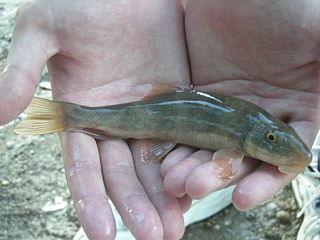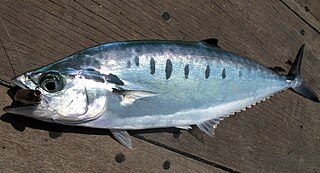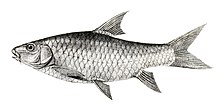
Mahseer is the common name used for the genera Tor, Neolissochilus, Naziritor and Parator in the family Cyprinidae (carps). The name is, however, more often restricted to members of the genus Tor. The range of these fish is from Vietnam in the east and China in the north, through Laos, Cambodia, Thailand, Malaysia, Brunei and Indonesia, and across southern Asia including the countries of India, Nepal, Bhutan and Bangladesh within the Indian Peninsula, plus Sri Lanka, Pakistan and Afghanistan. They are commercially important game fish, as well as highly esteemed food fish. Mahseer fetch high market price, and are potential candidate species for aquaculture. Several of the larger species have suffered severe declines, and are now considered threatened due to pollution, habitat loss, overfishing and increasing concern about the impacts of unregulated release of artificially bred stock of a very limited number of species.

The Kali Sindh (Krashna Sindhu), is a river in Madhya Pradesh and Rajasthan in northern India. It is a tributary of the Chambal River in the Ganges Basin. The main tributaries of the Kali Sindh are the Parwan, Niwaj and Ahu rivers. The Kali Sindh River drains a major portion of the Malwa region, and is the biggest river flowing in the Malwa region of Madhya Pradesh.

Gwalior district is one of the 52 districts of Madhya Pradesh state in central India. The historic city of Gwalior is its administrative headquarters. Other cities and towns in this district are Antari, Bhitarwar, Bilaua, Dabra, Morar Cantonment, Pichhore, and Tekanpur. The district is at the centre of the Gird region.

The woundfin is a species of minnow endemic to the Virgin River of the southwestern United States. It is the only species in the monotypic genus Plagopterus.

Tor putitora, the Golden Mahseer, Putitor mahseer, or Himalayan mahseer, is an endangered species of cyprinid fish that is found in rapid streams, riverine pools, and lakes in the Himalayan region. Its native range is within the basins of the Indus, Ganges and Brahmaputra rivers. It was reported to be found in the Salween river, the natural border between Thailand and Myanmar as well, but the number is very rare, only three times in 28 years.

Schizothorax plagiostomus is a species of ray-finned fish in the genus Schizothorax. Schizothorax plagiostomus locally known as khont, snow trout, snow carp, snow barbel and swati fish has an elongated sub cylindrical body with short, blunt and slightly prognathous upper jaw. Ventral surface of head and anterior part of body flattish, short, somewhat cone shaped and blunt. Snout usually smooth covered with warys in male. Interorbital space broad and flat. Mouth inferior, wide and slightly arched; lips fleshy and continuous, marginally sharply attenuated, lower lip papillae and reflected from jaw, margin of lower lip sharp, covered with firm and hard horny cartilage; a strip of papillae labial plate at chin present. Barbless two pairs. Pharyngeal teeth in three rows. Dorsal fin inserted about opposite to pelvic fins, its last undivided ray osseous, strong and serrated posterior, short than head. Caudal fin deeply emarginated. Scales very small and elliptical; lipids irregular.

Tor douronensis, also known as Labeobarbus douronensis, is a species of ray-finned fish of the family Cyprinidae in the genus Tor. This Asian fresh water river carp can be discovered in southern Thailand, east to Vietnam and south to Indonesia. The species is known from the Chao Phraya and Mekong rivers.
This fish has been attributed to Valenciennes however, in his original notes, he claims that the fish he described "formed part of the collection made in Java by Kuhl and Van Hesselt; they named it Dourr." Certainly, the type locality is Java, in Indonesia and the holotype is lodged at Bogor Zoology Museum.

The desert sucker or Gila Mountain sucker, is a freshwater species of ray-finned fish in the sucker family, endemic to the Great Basin and the Colorado River Basin in the United States. It inhabits rapids and fast-flowing streams with gravelly bottoms. It is a bi-colored fish with the upper parts olive brown to dark green, and the underparts silvery-tan or yellowish. The head is cylindrical, tapering to a thick-lipped mouth on the underside. This fish can grow to 31 in (79 cm) in Arizona but is generally only about half this size elsewhere. There are three subspecies, found in different river basins, and some authorities allot this species its own genus Pantosteus.

Tor tor, commonly known as the tor mahseer or tor barb, is a species of cyprinid fish found in fast-flowing rivers and streams with rocky bottoms in India, Bangladesh, Bhutan, Nepal, and Pakistan. It is a commercially important food and game fish.
Tor sinensis, the Chinese or Red mahseer is a species of mahseer native to the Mekong River. It is known with certainty only from Yunnan, China; reports from Cambodia, Laos, and Thailand require confirmation.
It is one of four currently valid species described from China, the others being Tor laterivittatus, Tor polylepis, and Tor yingjiangensis.

Nemipterus bipunctatus, the Delagoa threadfin bream, Bleeker's threadfin bream or butterfly bream, is a species of marine ray-finned fish belonging to the family Nemipteridae, the threadfin and whiptail breams. This demersal fish is found over soft bottoms in the Indian Ocean.

Retroculus lapidifer is a species of cichlid native to tropical South America, where it is found in the rivers of the southeastern Amazon basin in Brazil. This fish was first described in 1855 by the French naturalist Francis de Laporte de Castelnau, who studied the fauna of South America while crossing the continent from Rio de Janeiro to Lima in an expedition starting in 1843 and lasting five years.

The humpback mahseer is a species of freshwater ray-finned fish from the Indian endemic genus Hypselobarbus in the carp and minnow family Cyprinidae.

Tor remadevii, the orange-finned mahseer, also known as the hump-backed mahseer, is a Critically Endangered species of freshwater fish endemic to the Western Ghats of India. It is restricted to the Kaveri river basin.

The needlescaled queenfish, also known as the slender queenfish, needleskin queenfish and slender leatherskin, is a tropical game fish in family Carangidae.

Tor tambra, the Javan mahseer, is a species of mahseer native to Southeast Asia.
Tor barakae is a species of mahseer native to Manipur, India.

Tor malabaricus, the Malabar mahseer, is a fish, a species of mahseer native to southwestern India.


















